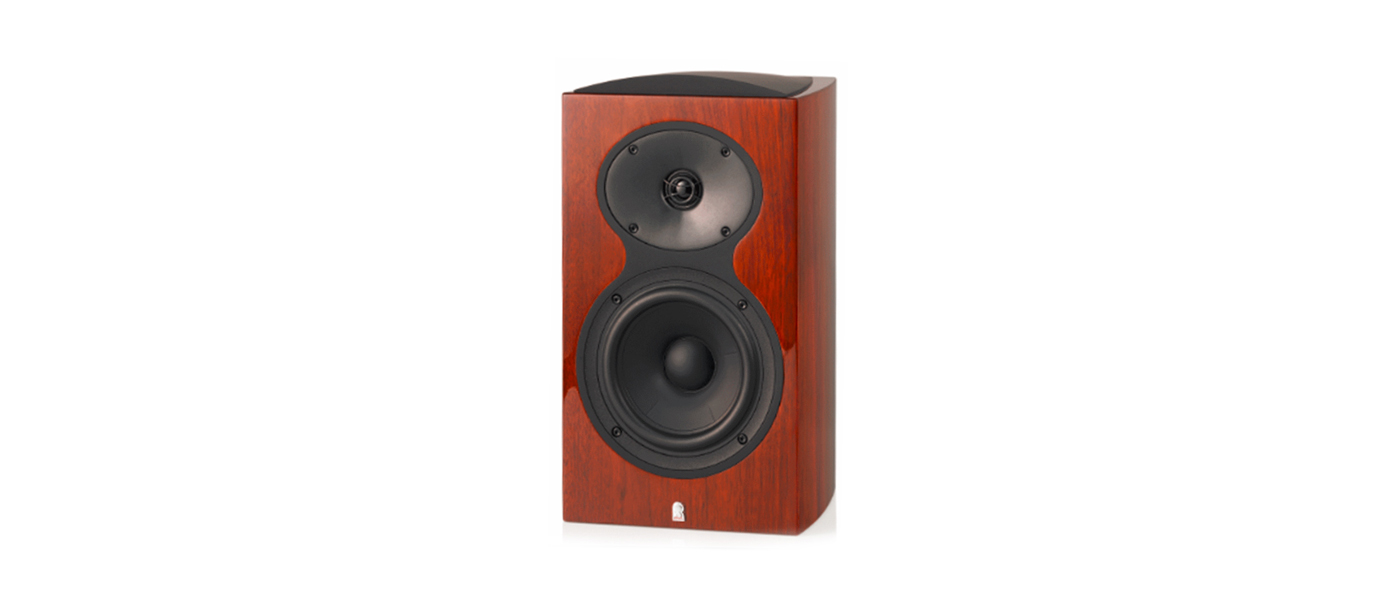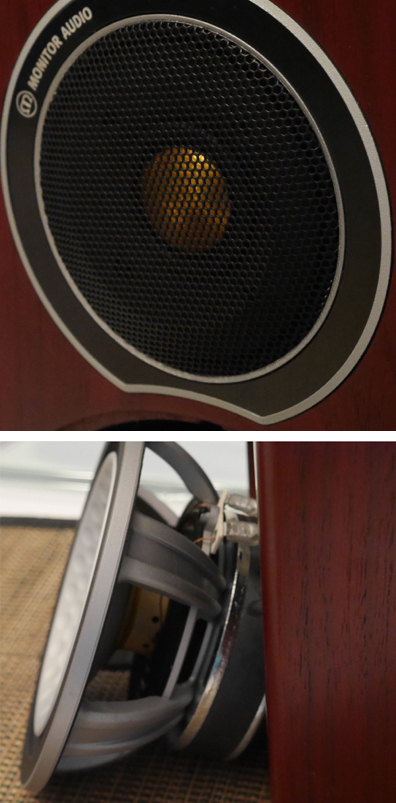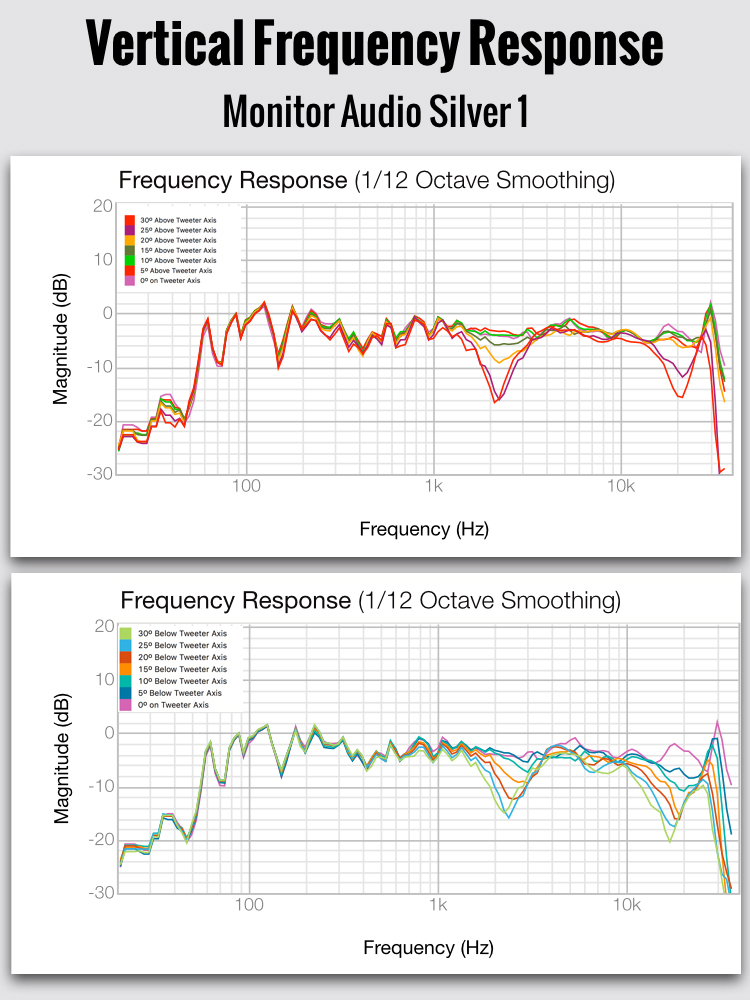The Monitor Audio Silver 1 combines a 6″ mid-woofer and 1″gold-anodized dome tweeter in a beautifully finished cabinet. Secrets last reviewed a Monitor Audio speaker, the GR10 over thirteen years ago. Fittingly, the Silver 1 descends from that speaker, with a similarly-sized midwoofer and gold-anodized dome tweeter. One key difference: the GR10 was $1,495 a pair in 2002, or about $2,000 after inflation. The Silver 1 is, in real terms, less than half the price. That’s progress!

Monitor Audio Silver 1 Bookshelf Loudspeaker
- Beautiful construction and finish
- Advanced proprietary drive-units
- Fantastic treble and surprisingly potent bass
- Slight upper midrange coloration; very sensitive to toe-in
- Grilles audibly and measurably degrade the sound
Monitor Audio is a British loudspeaker specialist over four decades old. They’ve earned a reputation for both advanced engineering and fine cabinetry. While Monitor Audio designs their products in the UK, they make many of their speakers, including the Silver 1, in China.
Design:
2-way Bass Reflex with Included Port Bung
Drivers:
1″ C-cam Gold Dome Tweeter, 6″ Concave Dished C-Cam RST Cone, Polymer Basket Woofer
Bass Alignment:
Rear Port; HiVe II Port System
Crossover Frequency:
3 kHz
Sensitivity:
87 dB, 1 W@ 1m
Nominal Impedance:
8 Ohms
Recommended Amplifier Power:
40 W-100 W
Dimensions:
12.3” H x 7.3” W x 9.5” D (Excluding Grille and Terminals)
Weight:
15.25 Pounds
Available Finishes:
Black Oak, Rosenut, Or Walnut Wood Veneer; High Gloss Black Or White Lacquer ($200 Additional Charge)
MSRP:
$875/pair
Company:
SECRETS Tags:
Bookshelf Speakers, Monitor Audio, Polar Map
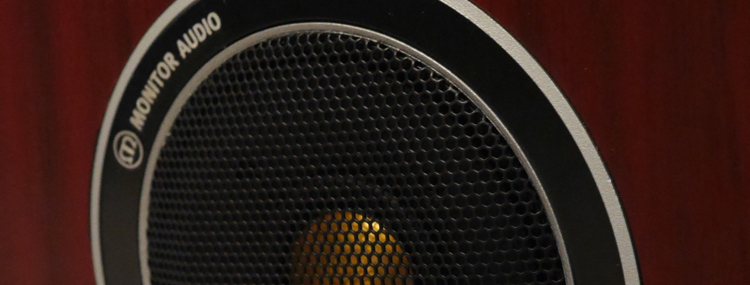
Monitor Audio offers four lines of traditional speakers: Bronze, Silver, Gold, and the flagship Platinum. The Silver line features wood-veneer cabinets, proprietary alloy woofers, and Monitor Audio’s longtime signature gold-anodized alloy dome tweeter. Monitor Audio’s Silver line also includes a bigger bookshelf speaker, a center channel, three towers, surrounds, and a subwoofer.
The Monitor Audio Silver 1 speakers are beautifully crafted. They look like luxury goods, with a depth and warmth that can only come from well-finished natural wood. The unmatched grain on the top panel is the only giveaway that each cabinet is not hewn from a single tree-trunk. Monitor Audio provided me a pair in “rosenut” veneer; They also offer the Silver 1 in two other veneers and (for $200 extra) black or white gloss lacquer.
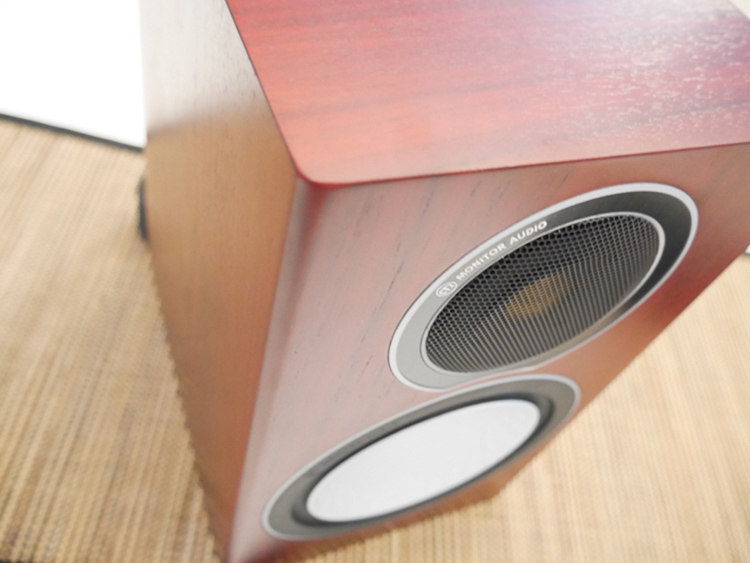
Monitor Audio conceals magnets under the veneer for the grille, instead of using fragile and unsightly pegs. The drivers sit flush with the baffle. Monitor Audio’s bolt-through driver design leaves the baffle fastener-free. Monitor Audio secures each driver with a stout rear-mounted bolt. Bolt-through driver mounting offers performance benefits in addition to cleaner lines. The bolts decouple the drivers from the baffle by pressing them against gaskets inset on the baffle. Additionally, these bolts serve as lossy front-back cabinet braces.
The Silver 1’s custom 6-inch midwoofer has a 1-piece dished cone made of a light-but-rigid aerospace alloy Monitor Audio calls C-CAM. The woofer’s inverted black rubber surround, combined with the silvery cone and trim ring, makes the cone appear free-floating. Neat trick. Monitor Audio calls the dimple pattern on the cone “RST.” They claim RST allows a lighter cone by increasing torsional resistance at high excursion.
The polymer woofer basket is very open, with large vents under the spider (the most important part of the woofer’s suspension) to reduce compression at long cone excursions. The woofer magnet is substantial. The Silver 1’s 25mm gold-anodized C-CAM dome tweeter has a wide cloth surround, deep back chamber, and a metal mesh grille to protect the dome from errant fingers.
The Silver 1’s rear panel has a rifled “HiVe II” port, driver mounting bolt-heads, and two pairs of jumpered binding posts to allow biwiring or biamping for those into that sort of thing. While the Silver 1’s binding posts are too short to completely sheathe sawtooth-type bananas, they are fine for conventional bananas, spades, pins, and of course bare wire.
All tracks below streamed from our home media server. Preamp/DAC was either Monitor Audio’s Airstream A100 integrated AirPlay DAC/amplifier (review forthcoming) or a MacBook Pro and Meridian Explorer DAC. Amps were the A100 (50W/8 Ohms), Pro-Ject Amp Box SE (90W/8 Ohms) and Parasound Zamp v3.2 (45W/8 Ohms). With no bass management, I ran the Silver 1s without subwoofers.
Secrets Sponsor
I placed the Monitor Audio Silver 1s atop Blu-Tack balls on 30-inch stands in my study. That put the tweeter axis just below my seated ear height of about 45 inches.
I tried the Silver 1’s ports both open and plugged. I preferred them open in this subwooferless setup. With ports open, the Silver 1 provided surprising bass extension, grunt, and articulation for speakers of their size and efficiency. I tried listening with the grilles on at first, because visible drivers draw my focus away from the music. I packed them away after a short on vs. off comparison. The grilles veiled the sound of woodwinds, strings, and female vocalists.
I began placing the Silver 1 pair in a classic equilateral triangle, with my nose the third point. After fine tuning, the speakers ended up a little closer to each other than to the listening position. So placed, the Silver 1 pair provided excellent center fill and allowed the acoustic scene to fill the width of the room.

“The Magic Whip” was my favorite album of 2015, despite suffering from “hipster coffee shop background music” levels of dynamic compression. This is one of those albums you enjoy for the performance, not the sonics.
And what a performance! Leisurely-delivered vocals float over percussive guitar and synth riffs. Blur infused “The Magic Whip” with just enough 1990s Britpop nostalgia to initially grab my Gen-X ears, but from that base spawned a wholly contemporary rock recording.
Secrets Sponsor
I found “The Magic Whip” a great help in fine-tuning speaker placement. Toe-in impacted both the Monitor Audio Silver 1’s upper midrange tonality and imaging. On “Thought I Was a Spaceman,” too little toe-in accentuated the recording’s existing upper midrange hardness, and the image lost some definition. When I fired them straight at my nose, some but not all of that hardness receded, and the image snapped into focus. Too much toe-in, and the upper midrange turned steely, while the soundstage collapsed inwards. Another track from this album, “There Are Too Many of Us,” showcased the Monitor Audio Silver 1’s excellent upper bass heft and definition.

“Perpetual Motion” has a quirky conceit: diverse classical works arranged for an eclectic chamber ensemble – including Fleck on banjo! Fleck’s banjo is surprisingly malleable in tone. He mostly ditches the twang he brings to Flecktones and bluegrass recordings, imbuing his banjo with an improbably baroque tonality.
As if to prove his technical virtuosity, Fleck absolutely slashes through Chopin piano etudes and Paganini violin-wreckers. And then he delicately plucks his way through some Bach. A beautifully-recorded marimba adds rich body and warmth to several of the tracks.
In particular, the arrangement of Debussy’s “”Doctor Gradus Ad Parnassum” sounded excellent on the Monitor Audio Silver 1’s, with warmth, foreboding, and drive. I found “Perpetual Motion” helpful to fine-tune the Silver 1’s stand height. Height was less critical than rotation, at least at my listening distance, but had a definitely audible effect. The Silver 1 speakers had the best balance with the tweeters just slightly below ear height. Much higher or lower turned the midrange a little boxy.
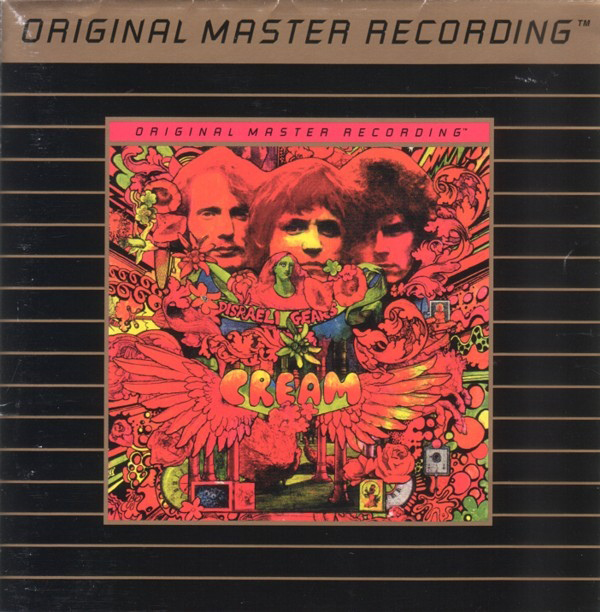
The stereo tracks on Mobile Fidelity’s Ultradisc II remaster of Cream’s “Disraeli Gears” combine a crisp top end with a notably stouter bottom end than other “Disraeli Gears” masters I’ve heard. Mobile Fidelity’s remaster is also more coherent than many Cream remasters. Here, Cream sounds like the supergroup they were; many other masters make the band sound like “Eric Clapton with Some Other Guys.”
The MSFL “Disraeli Gears” allowed the Silver 1 speakers to show off the best aspect of their sound: treble fidelity approaching the best beryllium and ceramic domes. The Silver 1 speakers faithfully convey the recording’s treble signature, be it sweet and extended or sibilant and harsh. On “Tales of Brave Ulysses” the Monitor Audio Silver 1’s superior treble performance elevated Ginger Baker’s drumming above the din with clarity and just the right amount of definition.

“The King of Limbs” (TKOL) is a deeply layered sonic collage that, while more about mood than melody, has its fair share of hummable-but-ethereal hooks. TKOL is nobody’s idea of a sonically pristine album, and is not an album to loop on a road trip: listener fatigue will set in. But for a spin or two, one accepts the edgy sonics to focus on emotionally and intellectually engaging the music.
Perhaps because of this somewhat sharp-edged master, TKOL exposed one notable weakness in the Silver 1 speakers’ presentation: a slight coloration in the upper midrange that I could minimize with toe-in but never completely eliminate. This coloration was present at the sweet spot, and worsened with lateral movement away from the sweet spot. This coloration added some grit to hi-hats, and extra blatt to the horns in “Codex.” I was, however, surprised that the Silver 1’s held up so well to the sonic onslaught of “Separator.” Often speakers will present a muddy midrange because the woofers move so much to reproduce the bassline. The Monitor Audio Silver 1 stayed unflappable through multiple plays.
Aside from the slight upper midrange coloration, I found little to complain about in the Monitor Audio Silver 1’s sound, given its size. It is a monitor that punches above its size down low and sounds as sweet as the recording lets it (or as grating as the recording demands) up top.
Fair warning: this section is necessarily a bit dense. If you only read one section of this bench report, skip down and read around the most sonically revealing measurement: the polar map.
One often reads complaints that measurements are useless for judging speakers. However, over the last two decades we have learned some measurements correlate highly with perceived good sound. The most perceptually relevant aspects of a speaker’s performance, by far, are frequency response flatness and smoothness on axis, and frequency response smoothness off axis. Accordingly, my bench sections focus heavily on frequency response. Especially off-axis frequency response, through polar maps that are a giant pain to make but graphically explain previously mysterious aspects of speaker sound in rooms. I take impedance measurements as soon as I receive speakers for quality control. All other measurements wait until I finish my listening notes, to avoid biasing my audition.
Here is the Monitor Audio Silver 1’s impedance.
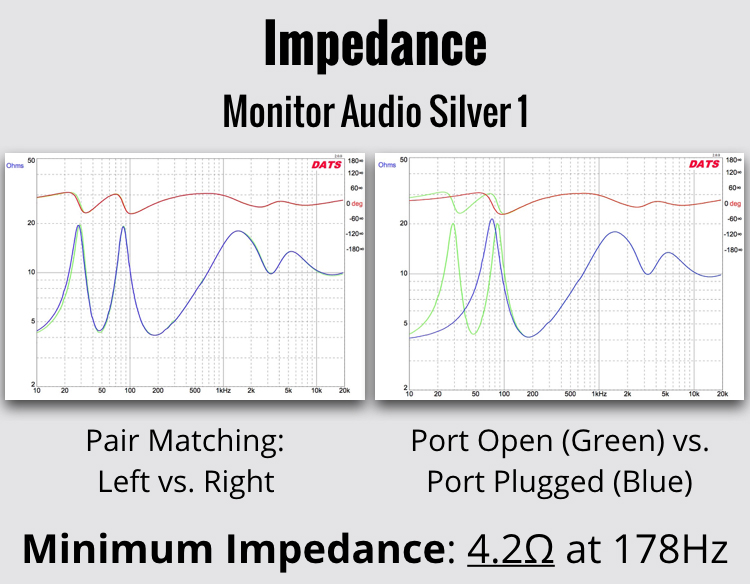
The left graph above shows the impedance curves for both review speakers. The near-perfect overlap indicates superb quality control. The “saddle” in the impedance curve indicates a port tuning of about 45Hz. The phase angle goes no steeper than about 20 degrees around the 4.2 Ohm minimum impedance, so any decent AVR or separate amp should drive them fine. The large impedance swing (from 4.2 Ohms in the upper bass to about 18 Ohms in the midrange) suggests the Silver 1 speakers may sound different on tubes than on solid state amps.
The right graph above compares the impedance with port open, and with port plugged using the included “bung.” The bung works as intended: it converts the vented box to a closed box with a single resonant peak. With port plugged, box resonance is about 70Hz with medium-low Q, ideal for bass management in a home theater setup.
The next graph shows the Silver 1’s acoustic crossover, with the woofer response (red), the tweeter response (blue), and the summed response (magenta).
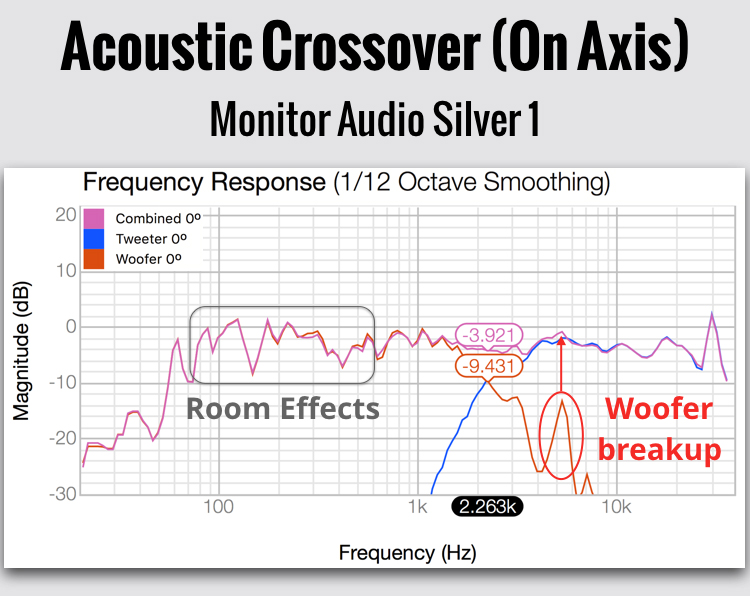
The 2.26kHz measured crossover point falls significantly below the specified 3kHz. Except for the interruption caused by the woofer’s breakup, both woofer and tweeter crossover slopes closely fit 4th order Linkwitz-Riley acoustic targets: down 6dB at the crossover point, 24dB/octave slopes. Driver levels are well balanced. The tweeter is admirably flat, and extends beyond 20kHz. Most tweeters with such sky-high breakup have spendy beryllium or ceramic diaphragms.
I measured relatively high odd-order harmonic distortion at the woofer breakup (not shown). However, I found nothing in my listening notes, such as listening fatigue, to suggest an audible distortion issue. I’d expect the woofer breakup notched out on a $2000 mini-monitor regardless of audibility. That sum should buy a small speaker with unimpeachable measured performance. At its price-point, Monitor Audio reasonably avoided the complexity and cost of shoehorning another notch filter into the woofer crossover.
Unlike harmonic distortion, smooth off-axis response correlates highly with speaker preference in blind tests. As Dr. Floyd Toole recently noted in a lecture at McGill University, “what we want is a loudspeaker that maintains something resembling a constant directivity over a wide range of frequencies. In that way and only in that way will we achieve this ideal performance of the direct sound matching the timbre of the reflected sounds.” The best way (so far) to visualize off axis response smoothness and dispersion is a polar map.
Unfortunately, polar maps rarely appear in hi-fi speaker reviews. Other examples of polar maps may help for context, particularly if you can find polar maps of speakers you’ve heard. My speaker reviews here at Secrets (e.g. Bryston Mini A), provide polar maps when practicable. For additional context, Princeton University’s 3D3A Labs maintains a database of polar maps with home, pro, and DIY speakers. Dr. Earl Geddes maintains a sophisticated, albeit not Mac/iDevice compatible, polar map database app. Use external apps at your own risk!
The polar map below shows the Monitor Audio Silver 1’s frequency response over the horizontal plane, measured in 5-degree increments. The “edge” of the dispersion pattern is yellow. The vertical dotted line denotes the acoustic crossover point.

The Monitor Audio Silver 1’s spade-shaped polar map shows its most audible measured flaw: a dispersion disruption in the upper midrange. The midwoofer loses energy in the octave below the crossover, but above the crossover the tweeter is relatively non-directional. Sonically, this spade-shaped polar map indicates reflections will contain more upper midrange than the direct sound. The timbral mismatch between the direct and reflected sound most likely causes the Silver 1’s sensitivity to toe-in and upper midrange coloration. It also causes “sweet spotting:” the soundfield only coheres tonally and spatially in a very small listening area.
The Monitor Audio Silver 1 is not unique here. Every 2-way speaker with 6-to-7-inch woofer and flat-faceplate tweeter behaves similarly, unless the woofer-tweeter crossover falls an octave below the Silver 1’s. That nearly never happens.
The next graphs show the Monitor Audio Silver 1’s measured off-axis performance above and below the speaker.
There are no major peaks in the vertical axis. Nulls, which are subjectively less noticeable than peaks, form both above and below the tweeter at the crossover. The resulting lobe is slightly top-biased, so the tweeters should be at or slightly below ear height. Perhaps that is why I found them to sound a little boxy when I stood up. I never listened to them while sitting on the floor.
While the Monitor Audio Silver 1 does not escape the upper midrange dispersion disruption inherent in 2-way speakers with 6-to-7-inch woofers and flat-faceplate tweeters, the next graphs shows the nearfield “NRC Listening Window” response, a 5-point average of on axis and 15 degrees up, down, left and right.
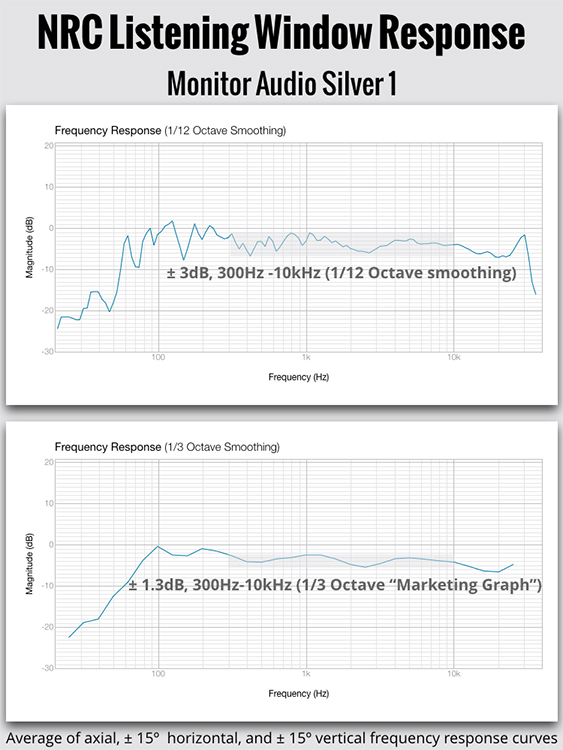
The Monitor Audio Silver 1’s NRC listening window frequency response is generally flat, except for a small dip in the crossover region. See the shaded region on each graph. Exclude the dip at about 450Hz, and the listening window response fits into a window even tighter than the shown 6dB. This dip is likely a measurement artifact. Below about 300 Hz, room effects dominate any speaker’s performance, but room issues do not suddenly disappear at 300Hz.
Furthermore, the Silver 1’s measured listening-window response validates Monitor Audio’s claimed 45 – 35k Hz frequency response, even at high resolution. The Silver 1 was able to fully excite a 60 Hz mode in the measurement room; 35kHz is just above the tweeter breakup.
A a 1/3-octave smoothed frequency response is provided for comparison purposes. Some review publications use 1/3 octave smoothing, as do most manufacturer-published measurements.
I took all measurements above with grilles off, because that is how I listened. The graph below confirms my decision to discard the grilles. I captured the difference in frequency response between grille-off and grille-on using an older version of FuzzMeasure, because the current version does not yet support division operations.
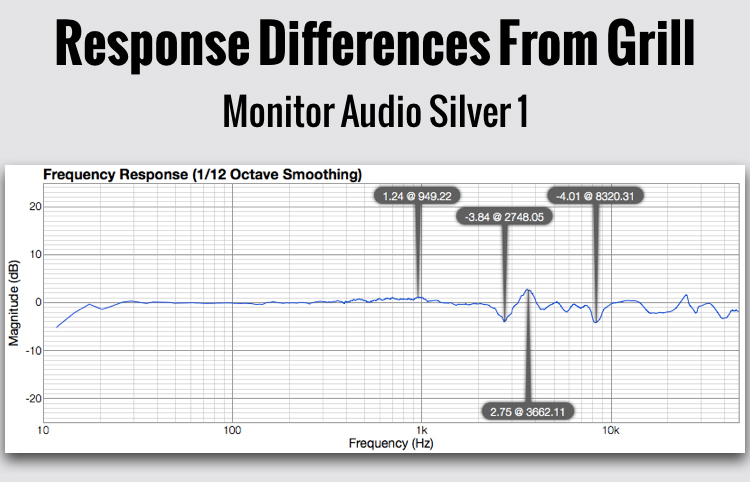
The grille more than doubles the Monitor Audio Silver 1’s frequency response variance in the upper midrange, where the ear is very sensitive to small differences.
Interestingly, the Bryston Mini A has a similarly-constructed magnetic grille of similar width. Yet its grille barely affected the sound or measured performance. I suspect the difference in how much the grille affects the upper midrange performance depends on tweeter dispersion. A flat faceplate tweeter fires more upper midrange energy at the grille frame than a waveguide-loaded tweeter such as the Mini A’s. More upper midrange energy directed at the grille frame means more upper midrange energy to diffract off the grille frame: therefore, subjectively and objectively greater sonic degradation.
THE MONITOR AUDIO SILVER 1 Offers a Beautiful Cabinet and Good Sound.
- Build and finish quality
- Outstanding treble
- Bass quality and quantity (for the size)
- Value for money
- Smooth upper midrange dispersion
- Sonically benign grille
The Monitor Audio Silver 1 is a nice-sounding and beautifully-finished mini-monitor. It has some upper midrange coloration, likely from the dispersion disruption around the crossover point that shows up plainly in the polar map. The Monitor Audio Silver 1 thus requires careful attention to placement and toe-in to optimize tonal balance for a sweet spot in a typical room. Also, its grilles are strictly decorative.
But perhaps I unfairly single out Monitor Audio’s plucky Silver 1. Two-way speakers with 6-to-7-inch woofers and flat-faceplate tweeters dominate the home speaker market, despite this dispersion disruption. This commercial success implies audiophiles generally tolerate the inevitable upper midrange colorations. The 6-to-7-inch woofer 2-way monitor does offer a nice compromise between speaker size/footprint, output capability, design complexity, and bass extension. Still, I would love to see Monitor Audio load their world-class tweeter into a shallow waveguide to control its upper midrange dispersion, as Bryston and Revel do.
Aside from the upper midrange dispersion issue that many listeners seem less sensitive to than I am, the Monitor Audio Silver 1 is an excellent speaker. Its fit and finish rivals or exceeds speakers its size two price classes up. The Silver 1’s crossover shows engineering excellence both heard and measured, and the tweeter is a marvel. Sonically, the Monitor Audio Silver 1 has gutsy bass, and treble that’s a window into the source material. Monitor Audio’s Silver 1 does an awful lot right, looks beautiful, and is worth a close listen.


